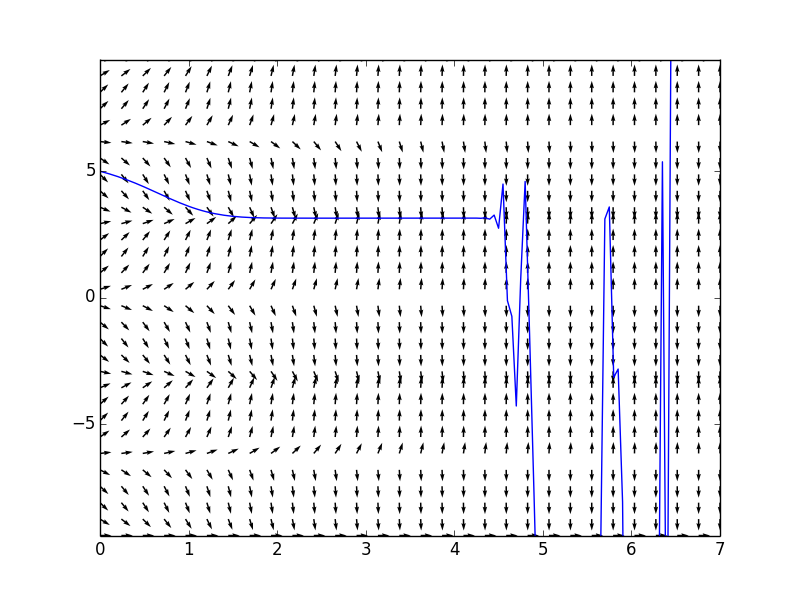欧拉方法
给定一个微分方程和初值:
$$\frac{dy}{dt}=f(t,y(t)),\qquad y(t_0)=y_0$$
在不求解的前提下,想要获得一个近似解,最简单的方法之一是欧拉方法。
欧拉方法中,我们设定一个步长(step size)$$\delta t$$,依据线性近似的公式:
$$y(t{i+1})=y(t_i + \Delta t)=y(t{i})+\frac{dy}{dt}\bigg|_{t=t_i}\Delta t+O({\Delta t}^2)\
\qquad \approx y(t_i)+y'(t_i)\Delta t$$
迭代地获得近似解。
举例:
$$\frac{dy}{dt}=y^2-t, \qquad y(0)=0,\qquad \Delta t = 0.5$$
Python中定义欧拉方法:
import sympy
from sympy.abc import t
from sympy import Function
y = Function('y')
formula = y(t)**2-t
def eulerMethod(formula,tval,yval,step,numSteps,percision = 5):
tvals = [tval]
yvals = [yval]
for i in range(numSteps):
m = round(formula.subs({y(t):yvals[-1],t:tvals[-1]}),percision)
tvals.append(round(tvals[-1]+step,percision))
yvals.append(round(yvals[-1]+m*step,percision))
return tvals, yvals
tv,yv = eulerMethod(formula, -1.0, -0.5,0.5,4)
for i in range(len(tv)):
print "after step {0} the t value is {1} and y value is\
{2}".format(str(i),str(tv[i]),str(yv[i]))
# output is :
# after step 0 the t value is -1.0 and y value is -0.5
# after step 1 the t value is -0.5 and y value is 0.125000000000000
# after step 2 the t value is 0.0 and y value is 0.382812500000000
# after step 3 the t value is 0.5 and y value is 0.456085205078125
# after step 4 the t value is 1.0 and y value is 0.310092062223703
欧拉方法的精确地取决于:
1. 微分方程本身
2. 步长
欧拉方法是最基本的定步长(fixed-step-size)数值近似方法,$$\Delta$$为常数,是一个一阶算法(first-order algorithm): $$\text{error}\leq C\cdot (\Delta)^1$$,通常,如果步长减半,通常误差也会减半。
欧拉方法之外还有很多计算更简便却精度更好的算法,例如Runge-Kutta方法,经典的RK方法是4阶的,意思是,如果步长减半,误差通常会减小为$$\frac{1}{2^4}$$。
定步长方法并不总是适用于所有情况,例如:
$$\frac{dy}{dt}=e^{t}siny,\qquad y(0)=5$$ 随着$$t$$值得增加,$$y(t)$$实际上应该是进入平衡,而非上下震动。
import numpy as np
tdomain = np.linspace(0,7,30)
ydomain = np.linspace(-3*np.pi,3*np.pi,30)
tval = 0
yval = 5
formula = sympy.E**(t)*sympy.sin(y(t))
def plotEulerAndSF(formula,tval,yval,step, tdomain, ydomain,percision=5):
fig = plt.figure(num=1)
numIter = int(float(tdomain[-1]-tdomain[0])/step)
tv,yv = eulerMethod(formula, tval, yval ,step, numIter,percision)
T,Y = np.meshgrid(tdomain,ydomain)
U = 1
V = np.array([[formula.subs({y(t): yval, t: tval}) for tval in\
tdomain] for yval in ydomain],dtype = 'float')
N = np.sqrt(U**2+V**2)
U2, V2 = U/N, V/N
plt.quiver( T,Y,U2, V2)
plt.plot(tv,yv)
plt.xlim([tdomain[0],tdomain[-1]])
plt.ylim([ydomain[0],ydomain[-1]])
return fig
fg = plotEulerAndSF(formula, tval, yval, 0.05, tdomain, ydomain)
fg.show()
